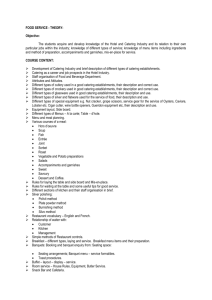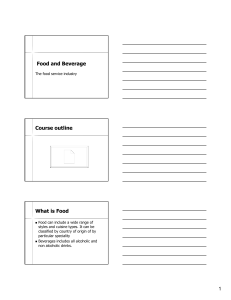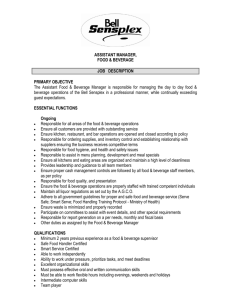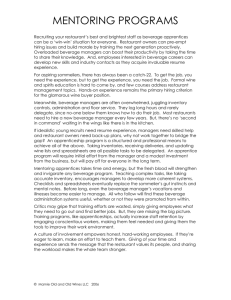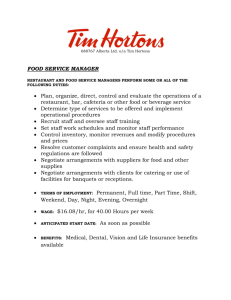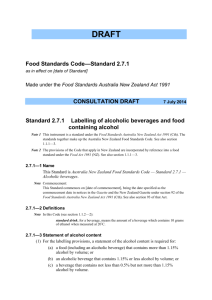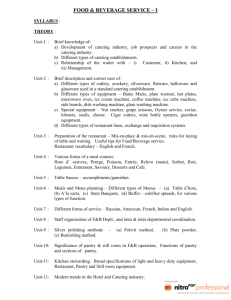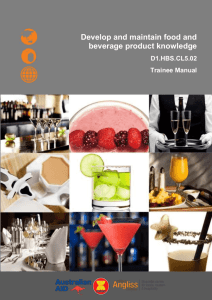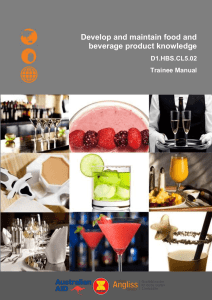2. Food & Beverage Service
advertisement
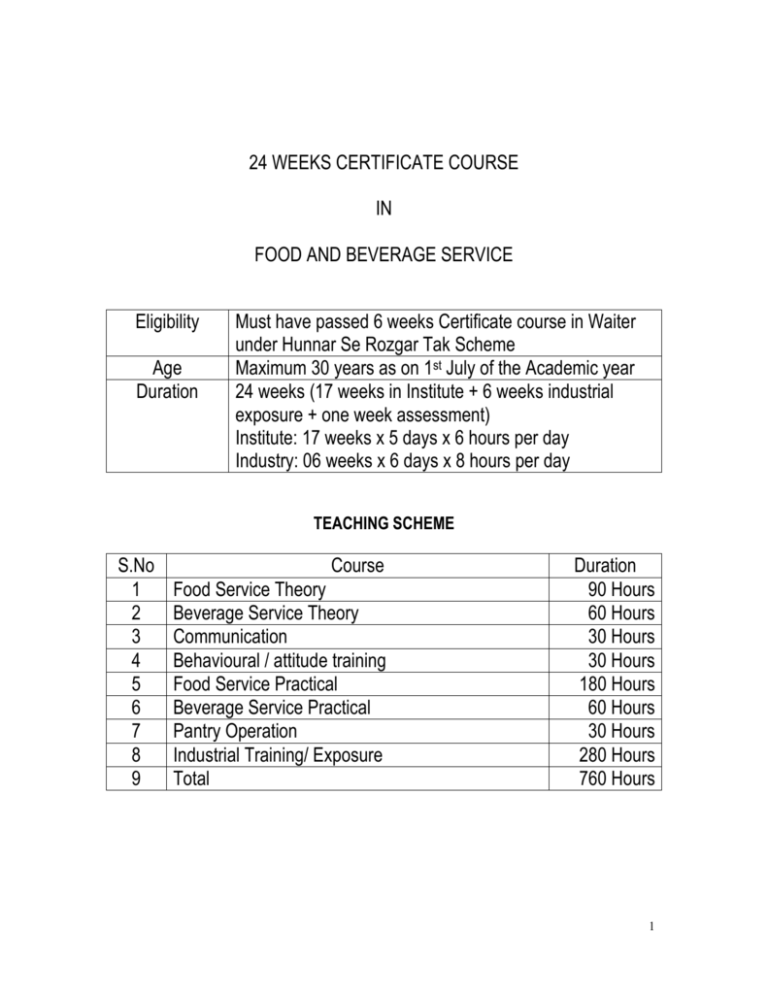
24 WEEKS CERTIFICATE COURSE IN FOOD AND BEVERAGE SERVICE Eligibility Age Duration Must have passed 6 weeks Certificate course in Waiter under Hunnar Se Rozgar Tak Scheme Maximum 30 years as on 1st July of the Academic year 24 weeks (17 weeks in Institute + 6 weeks industrial exposure + one week assessment) Institute: 17 weeks x 5 days x 6 hours per day Industry: 06 weeks x 6 days x 8 hours per day TEACHING SCHEME S.No 1 2 3 4 5 6 7 8 9 Course Food Service Theory Beverage Service Theory Communication Behavioural / attitude training Food Service Practical Beverage Service Practical Pantry Operation Industrial Training/ Exposure Total Duration 90 Hours 60 Hours 30 Hours 30 Hours 180 Hours 60 Hours 30 Hours 280 Hours 760 Hours 1 FOOD SERVICE THEORY Objective: The students acquire and develop knowledge of the Hotel and Catering Industry and its relation to their own particular jobs within the industry; knowledge of different types of service; knowledge of menu items including ingredients and method of preparation, accompaniments and garnishes, mis-en-place for service. COURSE CONTENT: Development of Catering Industry and brief description of different types of catering establishments. Catering as a career and job prospects in the Hotel Industry. Staff organisation of Food and Beverage Department. Attributes and Attitudes. Different types of cutlery used in good catering establishments, their description and correct use. Different types of crockery used in good catering establishments, their description and correct use. Different types of glassware used in good catering establishments, their description and use. Different types of silver and flatware used for the service of food, their description and use. Different types of special equipment e.g. Nut cracker, grape scissors, service gear for the service of Oysters, Caviar, Lobster etc. Cigar cutter, wine bottle openers, Gueridon equipment etc, their description and use. Equipment layout, Side board. Different types of Menus – A la carte; Table d’hote. Menu and meal planning. Various courses of a meal Rules for laying the table and side board and Mis-en-place. Rules for waiting at the table and some useful tips for good service. Different sections of kitchen and their staff organisation in brief. Silver polishing Restaurant vocabulary – English and French. Relationship of waiter with: Customer Kitchen Management 2 Simple methods of Restaurant controls. Breakfast – different types, laying and service. Breakfast menu items and their preparation. Buffet – layout – display – service. Room service – House Rules, Equipment, Butler Service. Snack Bar and Cafeteria. 3 BEVERAGE SERVICE THEORY Beverage Classification. Basic knowledge of the history, composition and service of alcoholic and nonalcoholic beverages; knowledge of equipment used in restaurants and auxiliary areas. Wines: Definition of wines; broad categories of wines; trade names of famous wines. Service of white wine, red wine and sparkling wine. Storage of alcoholic beverages. Brief description about spirits, whisky, rum, brandy and vodka. Basic knowledge of portions and cost control. Basic knowledge of liqueurs, mineral waters. Dispensing of spirits. Cocktails – different types of important cocktails and Rules for making cocktails. Beer service, trade names, storage and types. Simple Beverages – hot and cold and their preparation. 4 COMMUNICATION Objective: Students will be able to comprehend and communicate specific terms of speech in the specified areas; write essential reports. COURSE CONTENT: Messages, booking. Use of Vocabulary of the food and beverage. General: Reported speech and dialogue writing; Role Plan Analysing Situation; Dictation and comprehension related to the food & beverage industry. Verbal: Telephone Conversation. Person to person – with colleagues, customer, subordinate superiors. Social skills – Courtesy, apology, compliments, suggestion, recommendation, suggested selling. Non-Verbal: Body language – Gestures, Posture, Body movement, Hands etc. Written: Language Use of Food & Beverage Service terminology. Reservation, log book, message, KOT, billing, incident reports, bulletin boards. 5 FOOD SERVICE PRACTICAL Objective: The students develop skills in preparing mis-en-scene and mis-en-place for service, skills in taking orders, advising on menu choice, service of food and beverage and presenting of bills. . Apprising and drawing of silver, cutlery, crockery and special equipment. Hygienic handling of cutlery, crockery, glassware and trays. Proper laying and relaying of table cloth during meals. Correct use of waiter’s cloth. Arrangement of silver and other tables, side board appointments according to different menus. Correct methods of handling and re-laying of silver, glassware etc., during the meals. Correct handling and practice of service spoon and service fork for silver service. Service and clearing of a meal, course by course. Different methods of service. Napkin folding. Receiving and seating the guests, presenting the menu, and taking order from the customer. Passing the order to the kitchen, co-ordinating orders. Making and presentation of bills. Service of breakfast: English, Continental, Indian and American Preparation of Egg, cereals and other Breakfast items. Room Service Mis-en-place for meals, snacks and beverages, both for tray and trolley service – proper loading of trays, carrying and service. Execution of orders to the room. Layout and service of small tea parties. Sandwiches – preparation and service. Banquet laying and formal & semi-formal service. Coffee shop service. 6 BEVERAGE SERVICE PRACTICAL Service of water and other simple beverages – milk shakes, iced tea, cold coffee, chocolate, juices etc. Service of hot beverages, tea and coffee. Service of white wine, red wine and sparkling wines – presenting the bottle, removing the cork and service. Service of spirits, whisky, rum, gin, brandy etc. Service of cocktails and liqueurs. Service of beer. Service of cigars and cigarettes and their storage. 7 PANTRY OPERATION PRACTICAL PANTRY LAYOUT of a Restaurant. Different sections of the Pantry: Main pantry Still Room Silver Room/ Plate Room Scullery/ Wash up Floor Pantry Different equipment required in the Pantry, their operation, handling and upkeep. Major Equipment: Food Service Counter Hot Section and Cold Section Coffee Machine Microwave Oven Salamander Juicer/Blender (Electric) Plate Warmers Dish Washing Machine Ice Cream Counter Ice Cube Machine Water Cooler Refrigeration Minor Equipment: Proper upkeep and maintenance of all Holloware and Crockery. Mise-en-place for breakfast and meals: Coffee making Tea making Care and Service of Juices Sandwiches preparation Soda fountain operation Burgers preparation 8 INDUSTRIAL TRAINING: Student will log in 280 hours of on the job training after 17 weeks of in institute training i.e. 6 weeks x 6 days x 8 hours and can avail one day leave. 9
